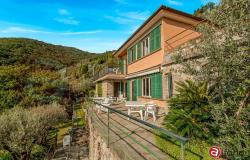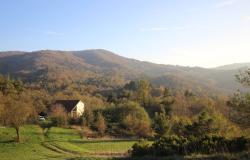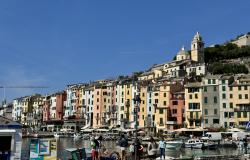What’s in a name? Well, a century ago the ‘Cinque Terre’ or ‘Five Lands’ could be reached only by sea or on foot along mountainous paths.
Thus, the somewhat grandiose epithet refers not to a series of once powerful self-governing kingdoms, but rather to five exorbitantly picturesque villages on the Ligurian coast, some 40 miles south of Genoa, that, until the railway blasted its way in during the 1890s, were very much places apart.
The railway connected the Cinque Terre with Sestri Levante and La Spezia, and thus ended centuries of splendid isolation.
Roads came later, and with them a trickle of tourists, though as recently as 1971 Waverley Root, in his book The Food of Italy, could still mistakenly write that the five villages could be reached ‘only by boat, or on foot, if you are a mountain climber’. These days, in summer, that trickle has become a torrent, so the area is best seen in spring and autumn.
If you come by car, the roads are not that high on the Italian scale of white-knuckle drives, but they will certainly keep your attention undivided.
Cars are not permitted beyond the entrances of the villages - praise be - so if you plan your visit outside of high summer you will see the Cinque Terre something like they must have been when fishing and not tourism was the chief source of income.
Most fetching, most crowded
 Though no longer isolated, they are still splendid, these five villages that cling to the beetling limestone mountains that heave themselves up from the Prussian-blue waters of the Mar Ligure.
Though no longer isolated, they are still splendid, these five villages that cling to the beetling limestone mountains that heave themselves up from the Prussian-blue waters of the Mar Ligure.
Of the Cinque Terre, Vernazza is by general consent the most fetching and, as a result, is also the most crowded. With its tall, multi- windowed, pastel-coloured houses, its quirky, Genoese parish church of 1318, its 11th-century Castle Doria, overlooking the tiny cove with its stone and rock protective quay curving seaward, Vernazza looks for all the world like the kind of place Mozart had in mind when he wrote Cosi Fan Tutte.
And if all this were not enough, the town boasts, in a restaurant called Gambero Rosso on the Piazza Marconi, an eatery where in summer you can sample the speciality of the house, Tian Vernazza - slices of potatoes with fresh anchovies, tomatoes and peas. Delizioso!
By contrast, perched as it is on a high cliff ridge, Corniglia seems to shun the seaside. So precarious is the village’s situation that it’s doubtful if today any builder would get planning permission to develop the site!
This eyrie of a village is all narrow lanes and four-storeyed houses, with sudden views over the sea that come on you unexpectedly when you turn a corner.
It’s a farming village, with vineyards lapping at its landward end and, paradoxically, the longest beach in the area, way below it - not that you’ll find golden sands if you make it down to the sea; beaches round here are of the stony sort.
Ravishingly lovely
 The three remaining villages - Monterosso, Riomaggiore and Manarola - are all one-time fishing communities, all ravishingly lovely, all with houses with several storeys, all clinging to the mountains that rise from the sea.
The three remaining villages - Monterosso, Riomaggiore and Manarola - are all one-time fishing communities, all ravishingly lovely, all with houses with several storeys, all clinging to the mountains that rise from the sea.
Monterosso is probably the most commercialised of all the five, but it does have the best beach.
Manarola is a colourful Lego land village wedged above a tiny ‘harbour’ with terraced vineyards hewn from the cliffs behind it. Here is ‘Marina Piccola’ where fresh, local seafood, simply cooked, is available at tables on a veranda overlooking the harbour.
Right across the street you can watch the local fishermen ‘launching’ their boats with winches down the cliffs into the rock-strewn sea.
Riomaggiore is shoehorned into a cleft in the mountains, its houses seemingly built one upon the other, so steeply do they rise tier upon tier away from the sea.
To get from the station to the old town, you have to walk through a tunnel - emerging from it into the colourful village and the sunshine is one of the not-to-be-missed experiences of the Cinque Terre.
 But to really tap into the genius loci of the area, you should walk the footpaths, the sentieri, that run along the hillsides from one village to the next. They are as old as the rocks themselves, these paths. Some climb and plunge like seaside roller coasters.
But to really tap into the genius loci of the area, you should walk the footpaths, the sentieri, that run along the hillsides from one village to the next. They are as old as the rocks themselves, these paths. Some climb and plunge like seaside roller coasters.
They come close to dizzying drops where only those with a rock-climber’s head for heights will want to gaze down into lonely coves.
These are paths where thyme, lavender and rosemary grow and, in spring, orchids flower amid juniper and Aleppo pines.
One such path connects Riomaggiore and Manarola and is called the Via dell’Amore and, being reasonably level, you don’t have to be as fit as a member of 3 Para to do it.
Paths like this take you past the untidy edges of the villages where the gardens of the locals are awash with vegetables, and by age-old olive trees and vines whose roots cling to the thin soils that overlay this land where level ground is as rare as a trustworthy spin-doctor.





